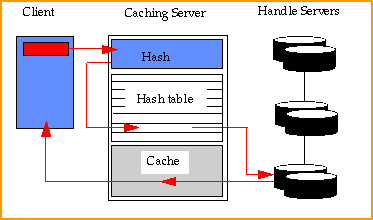
Identifiers and Handles
Desirable properties of identifiers
The following are desirable properties of identifiers in the digital library:
A handle is an identifier that satisfies the first group of criteria.
The CNRI Handle Management System is an implementation of the architecture that satisfies the middle group of criteria. Current activities are aimed at having
handles incorporated within standard user interfaces.
Syntax
The syntax of a handle is either:
naming_authority / locally_unique_string
or, for use in Internet applications,
hdl:// naming_authority / locally_unique_string
Examples
cnri-1/1995.02.12.16.42.21;9 (date-time stamp)
berkeley.cs/ucb-cstr-94.45 (semantic name)
Naming authorities
Names of naming authorities are unique for all time.
The Handle Management System has three components:
Handle Generators
Handle Servers
Handle Server Directory
The Handle Management System is in operation and available for public use.
Resolving a handle
The following diagram shows the most common way that the handle server can be used to resolve a handle and return references to the objects that it identifies.

A hash table is used to indicate which of the server computers holds the information associated with a specific handle. There are three standard configurations.
Handle Servers return a choice of all or subset of stored data.
Data associated with handles
Handles and the Handle Management System were designed for use in the digital library, but they can be used to store a wide range of data:


wya
February 1, 1995



